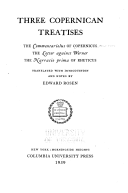Copernicus' Hypothesis
After I had addressed myself to this very difficult and almost insoluble problem, the suggestion at length came to me how it could be solved with fewer and much simpler constructions than were formally used, if some assumptions (which are called axioms) were granted me. They follow in this order.
There is no one center of all the celestial circles or spheres.
The center of the earth is not the center of the universe, but only of gravity and of the lunar sphere. All the spheres revolve about the sun as their mid-point, and therefore the sun is the center of the universe. The ratio of the earth's distance from the sun to the height of the firmament is so much smaller than the ratio of the earth's radius to its distance from the sun that the distance from the earth to the sun is imperceptible in comparison with the height of the firmament.
Whatever motion appears in the firmament arises not from any motion of the firmament, but from the earth's motion. The earth together with its circumjacent elements performs a complete rotation on its fixed poles in a daily motion, while the firmament and highest heaven abide unchanged.
What appears to us as motions of the sun arise not from its motion but from the motion of the earth and our sphere, with which we revolve about the sun like any other planet. The earth has, then, more than one motion. The apparent retrograde and direct motion of the planets arises not from their motion but from the earth's. The motion of the earth alone, therefore, suffices to explain so many apparent inequalities in the heavens.
Notes:
That the Earth revolves around the Sun.
Folksonomies: history science hypothesis
Taxonomies:
/business and industrial/energy/renewable energy/solar energy (0.494829)
/home and garden/home improvement and repair/locks and locksmiths (0.447174)
/science/physics/space and astronomy (0.436309)
Keywords:
earth (0.977740 (positive:0.434390)), highest heaven abide (0.806460 (neutral:0.000000)), firmament (0.803246 (positive:0.473988)), motion (0.798146 (negative:-0.370500)), sun (0.772727 (positive:0.125654)), insoluble problem (0.681584 (negative:-0.544760)), simpler constructions (0.674019 (neutral:0.000000)), apparent retrograde (0.656651 (negative:-0.456651)), lunar sphere (0.649475 (neutral:0.000000)), celestial circles (0.649046 (negative:-0.308150)), apparent inequalities (0.647273 (negative:-0.371359)), complete rotation (0.623232 (neutral:0.000000)), fixed poles (0.621295 (neutral:0.000000)), circumjacent elements (0.616611 (neutral:0.000000)), direct motion (0.599195 (negative:-0.456651)), daily motion (0.598508 (neutral:0.000000)), center (0.591789 (negative:-0.076621)), spheres (0.528037 (negative:-0.308150)), distance (0.514171 (positive:0.815538)), height (0.504421 (positive:0.815538)), ratio (0.501158 (positive:0.815538)), universe (0.493548 (negative:-0.079972)), axioms (0.467765 (neutral:0.000000)), Copernicus (0.466468 (neutral:0.000000)), assumptions (0.462505 (neutral:0.000000)), suggestion (0.461512 (neutral:0.000000)), Hypothesis (0.458461 (positive:0.573516)), length (0.452128 (neutral:0.000000)), motions (0.451706 (negative:-0.526018)), heavens (0.451070 (negative:-0.371359))
Concepts:
Sun (0.959561): dbpedia | freebase | opencyc
Earth (0.836689): dbpedia | freebase
Planet (0.727086): dbpedia | freebase | opencyc
Universe (0.683382): dbpedia | freebase
Solar System (0.646859): dbpedia | freebase | opencyc
Pluto (0.577933): dbpedia | freebase | opencyc | yago
Natural satellite (0.553461): dbpedia | freebase | yago
Retrograde motion (0.511931): dbpedia | freebase





